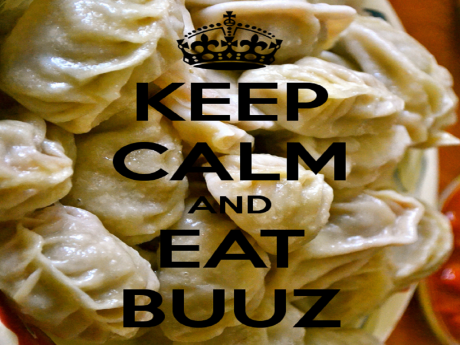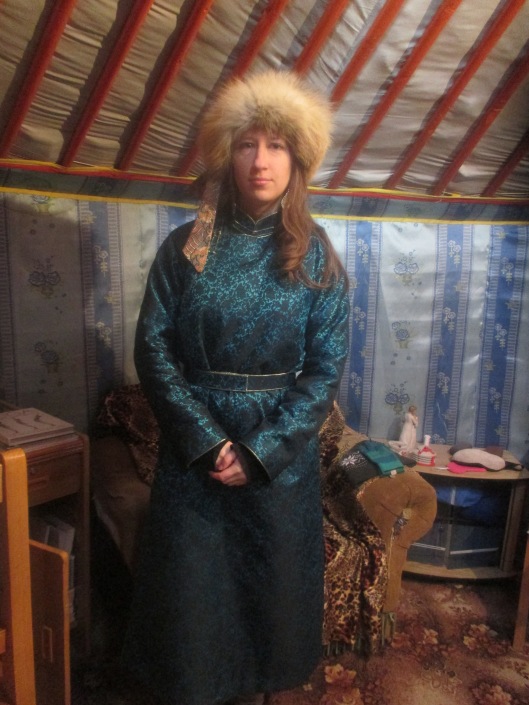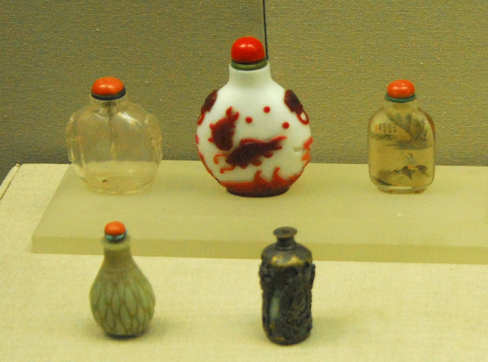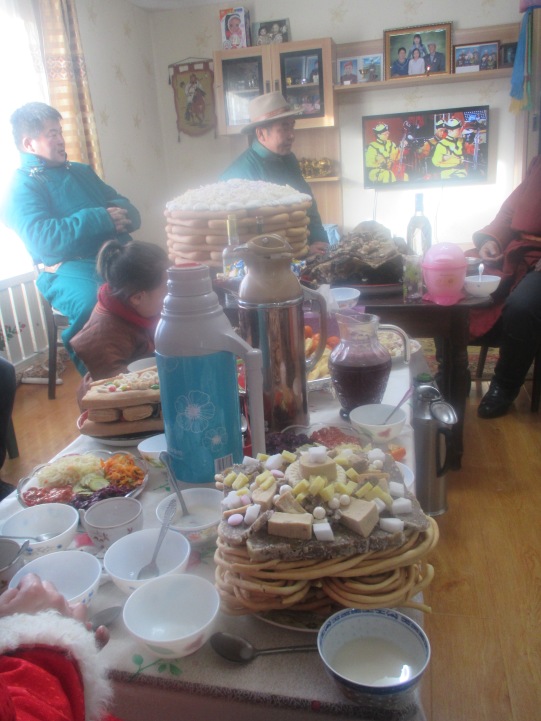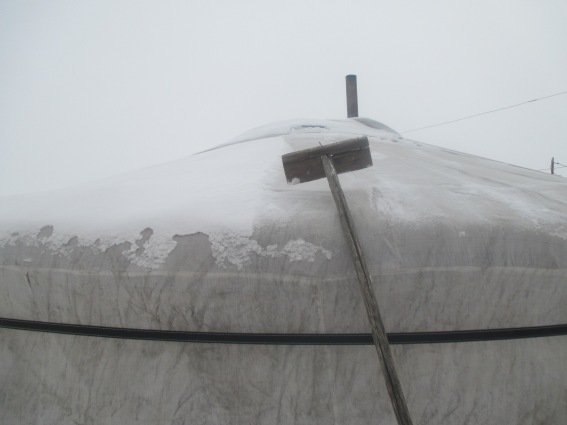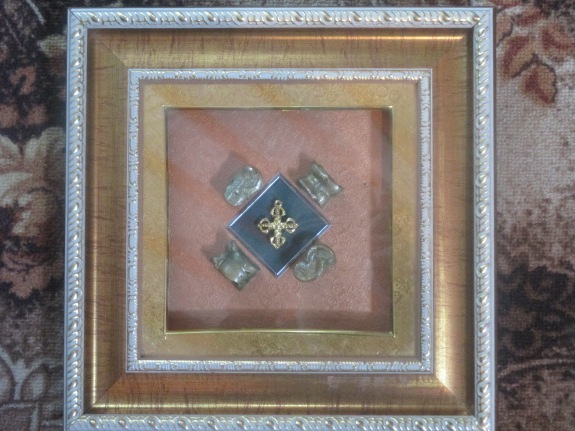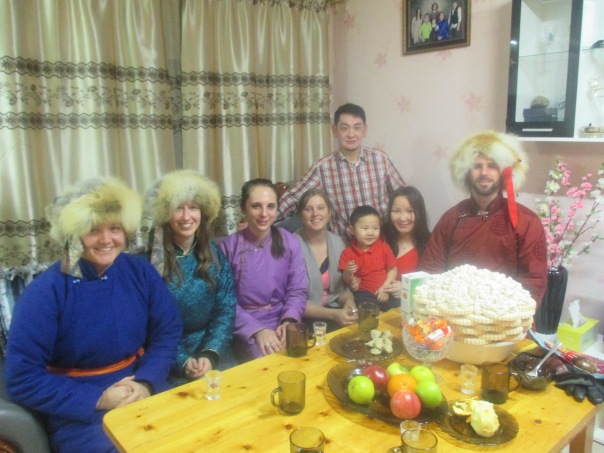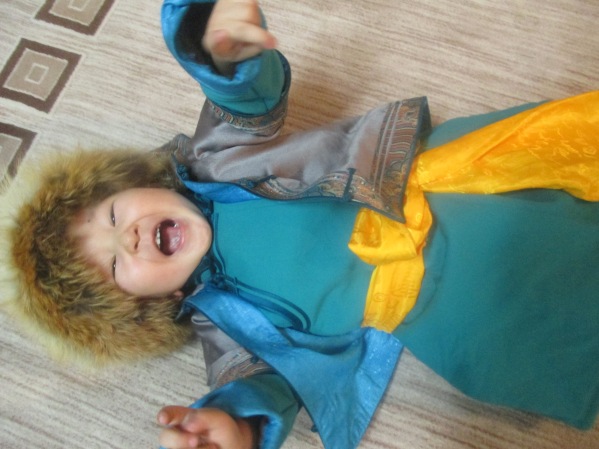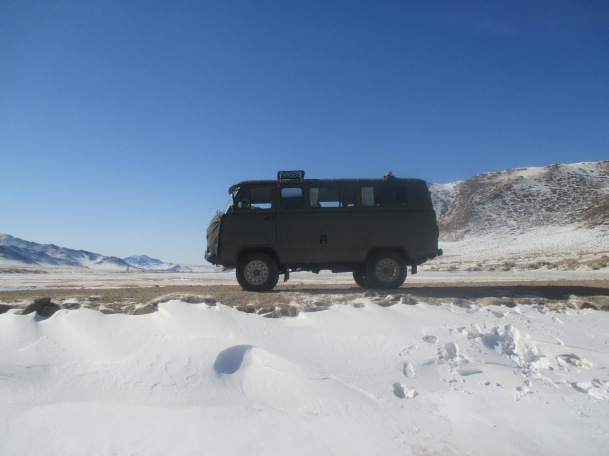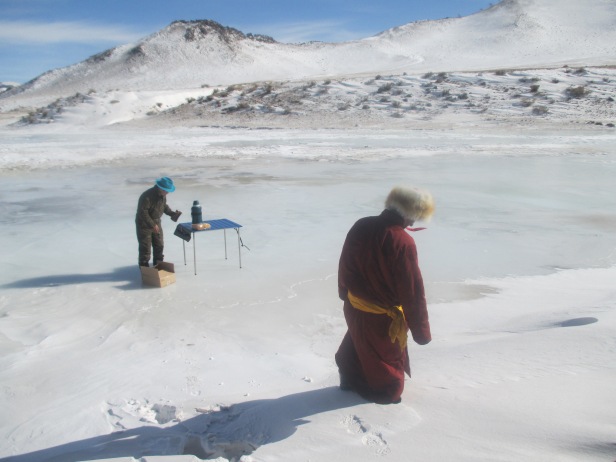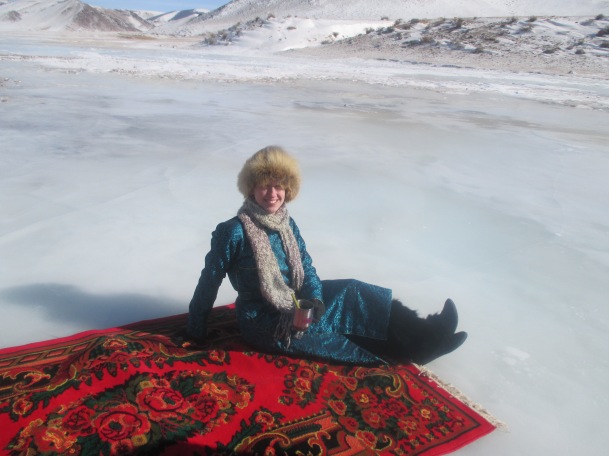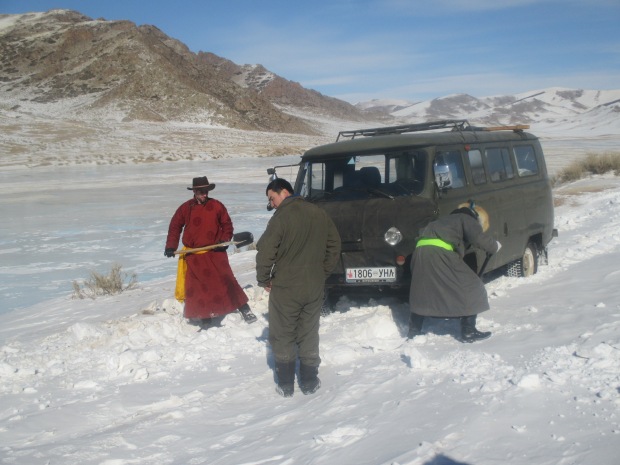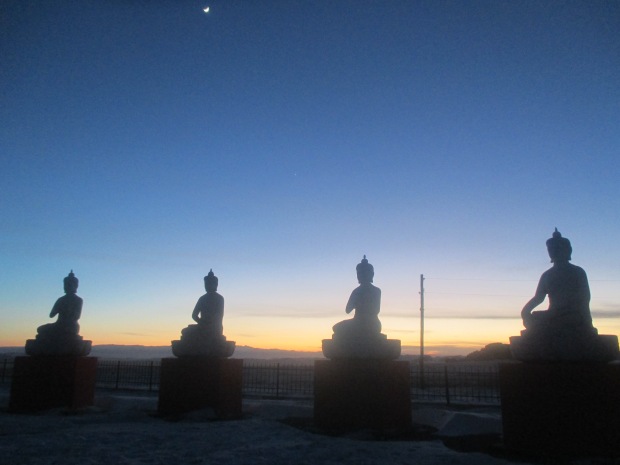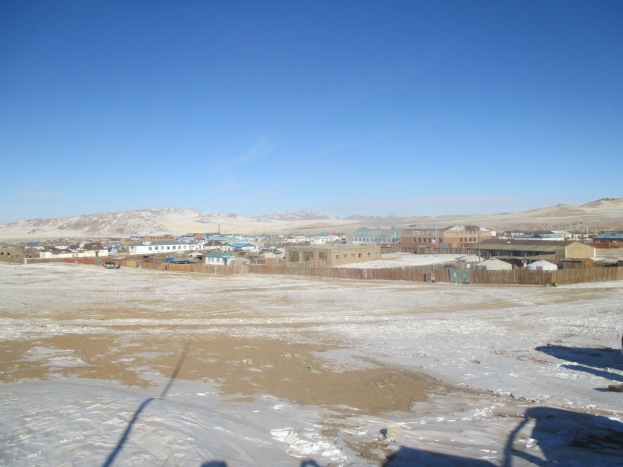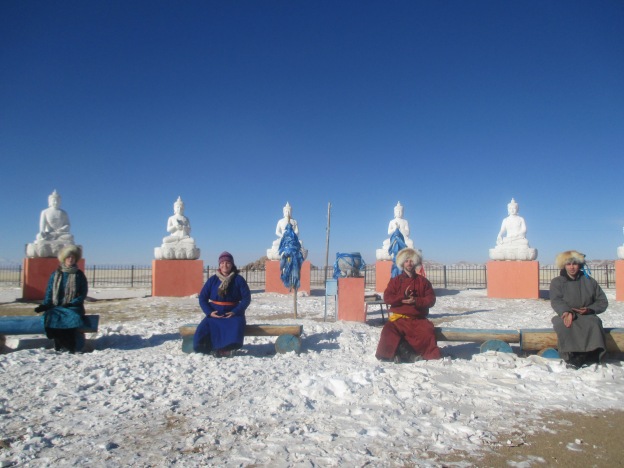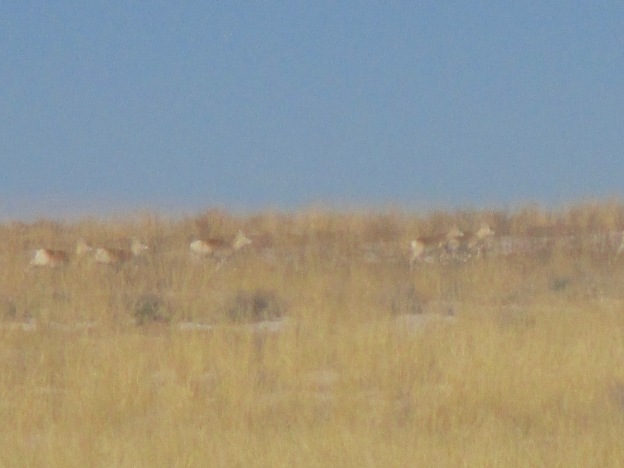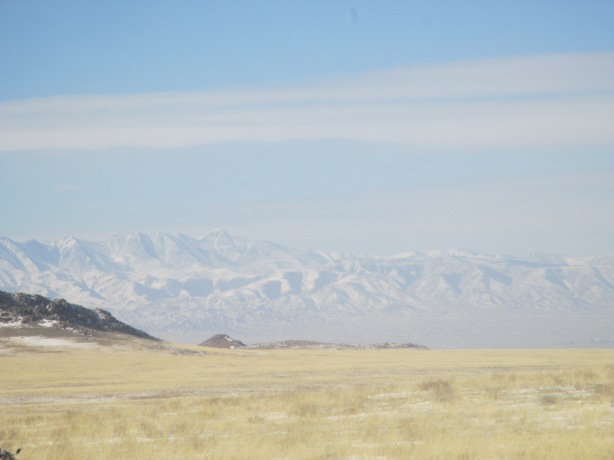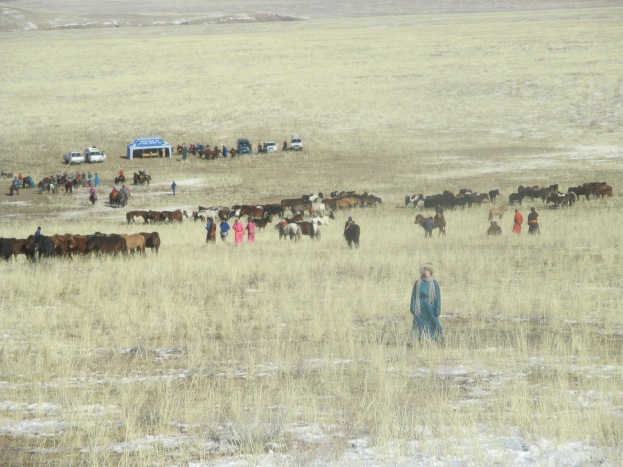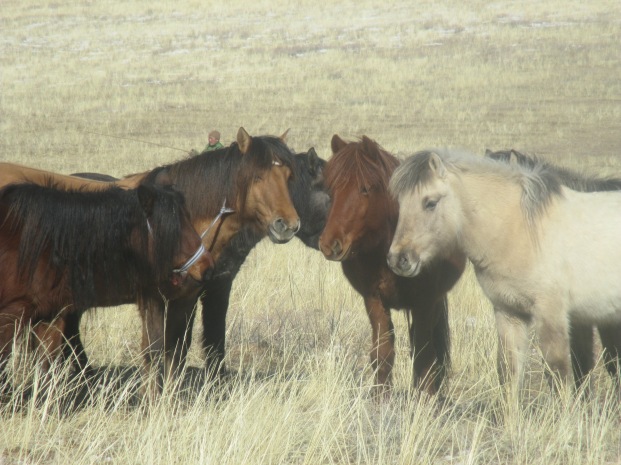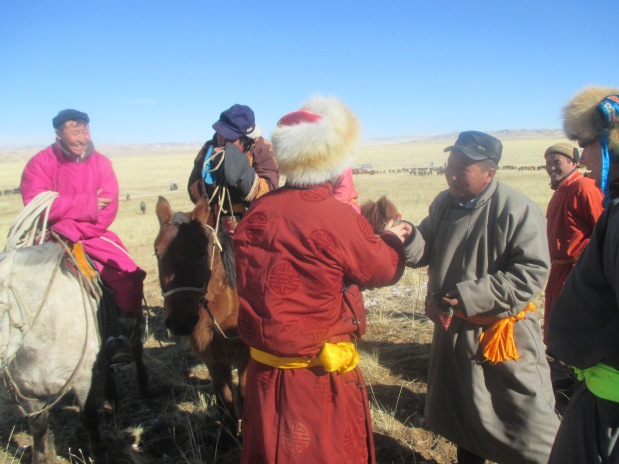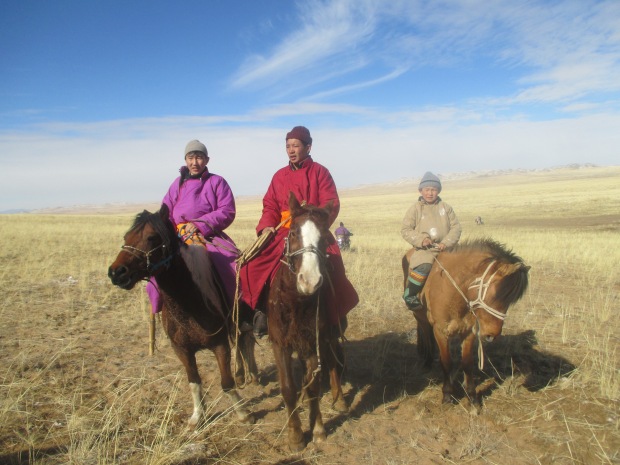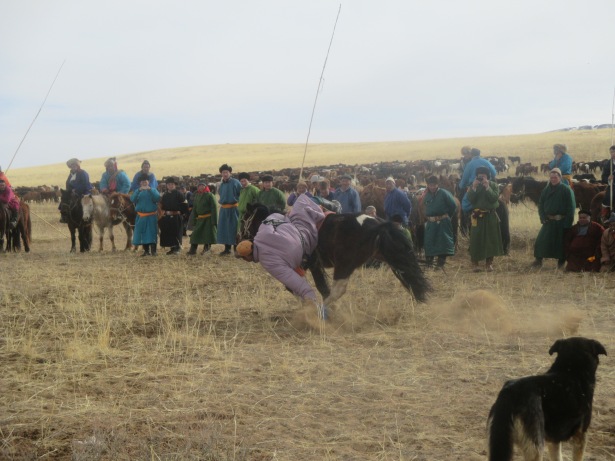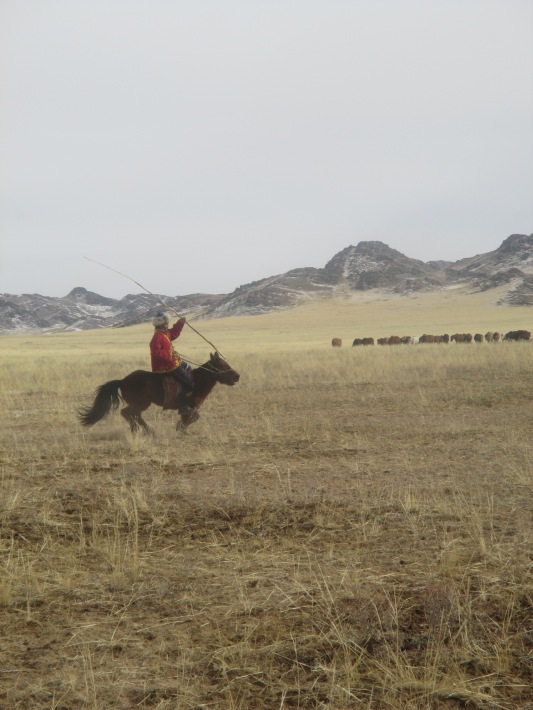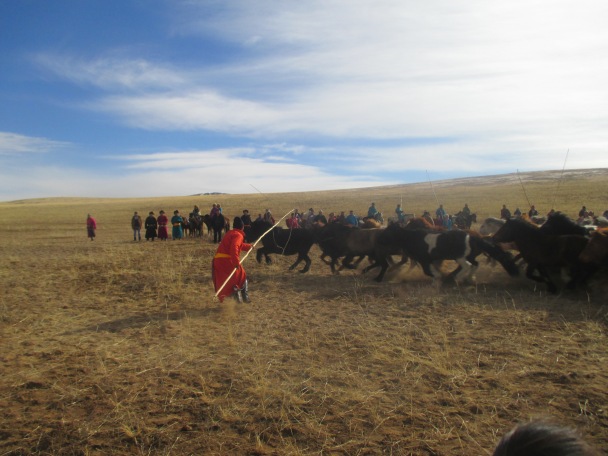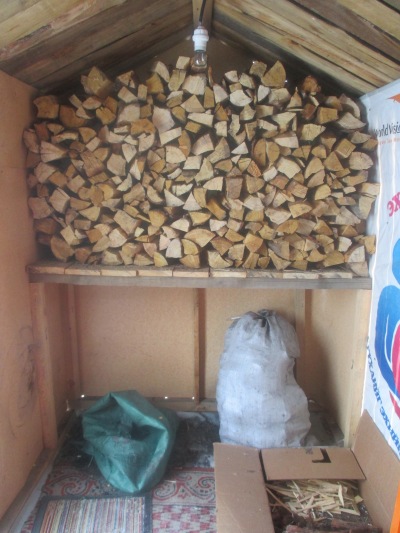WARNING: This post is very long.
A couple weeks ago, I was ambushed by my khashaa family as soon as I got home from work and told to come over and help them make bansh (a smaller version of buuz that is boiled instead of steamed) with a bunch of their extended family for Tsagaan Sar.
Just what is Tsagaan Sar, you ask?
Tsagaan Sar translates to “white moon” and is basically the Mongolian celebration of the Lunar New Year. It’s kind of a big deal here.
Tsagaan Sar lasts for an entire month (sar also translates to “month”), but the first 3 days are the most important and the ones that everyone celebrates and gets off work for. The first day’s celebration is typically reserved for family, while the second and third days are spent visiting with friends. Everyone wears their winter deel, boots, and fanciest hats. In cities and towns–even small ones out in the middle of nowhere like here in Uliastai–most people (the biggest exception is older people) don’t wear traditional Mongolian clothes very often. But Tsagaan Sar is when literally everyone wears their deel and traditional Mongolian hats. And you eat all the food–mostly buuz and bansh. Seriously, mutton dumplings for days.
If you want to read more about it, there’s a nice article about some Tsagaan Sar customs here and a cool infographic showing the (massive) expenses that come with the celebration here (for reference, 1 US dollar is equal to approximately 1900 Mongolian tugrik [MNT]).
This year, Tsagaan Sar began on Thursday, February 19th, but all the craziness leading up to it began much earlier. As I already mentioned, my khashaa family started making bansh weeks before the holiday, as many families do. I was there for almost 4 hours and participated in the making of literally hundreds—if not thousands—of bansh. I finally left because it was late, I was tired, and my already inferior bansh were starting to look uglier by the minute. I don’t know how long the rest of them continued at it or how many bansh were ultimately made, but considering we started out with 50 kilos of meat, I’m willing to bet it was a lot.
The Monday before Tsagaan Sar began, the stores and streets were packed with people preparing for the holiday. People were buying food to prepare whatever they had left to make and gifts to give to all their visitors (in the complete opposite fashion of American visiting custom, the host during Tsagaan Sar gives each visitor a gift, instead of the visitors bringing a gift to the host). People left work early to super-clean their homes (like, scrubbing-the-walls clean), and by 2pm on Tuesday I was one of about five people left at the health department (until they were all called back a couple hours later when the director returned from UB and called an impromptu meeting). Before my supervisor left for the day, she told me I didn’t need to come in on Wednesday because pretty much no one else would be anyway. Sweet! All the vacation but none of the housework! (Sorry, but I had no plans of inviting anyone over to my ger as that would require me to actually have a bunch of food prepared, which I cannot afford on my measly PC living allowance. Plus, I would be way too busy visiting everyone else’s homes over Tsagaan Sar to have people come to mine). But since I had the day off, I did do some cleaning anyway. Just in case someone happened to peek into my ger, I didn’t want them to recoil in horror at the lack of sparkling cleanliness (because you can’t start the new year with a dirty home).
Day 1
On the first day of Tsagaan Sar, I woke up at 7:30am to get my fire started and planned to get up and about at 8. I wasn’t sure what time I was supposed to go over to my khashaa family’s home to celebrate, but I wanted to be prepared. But when 8 o’clock rolled around, I remembered how much I love sleep. I set my alarm for 9 and dozed off again, until I was awakened by my khashaa dad calling my name from outside my ger. I jumped out of bed, yelled something in English (my brain can’t do Mongolian as soon as I wake up; and no, my khashaa dad doesn’t understand English), and started getting ready. A few minutes later, he came back to make sure I was actually getting ready (see: doesn’t understand English, above) and told me to put on “nice clothes.” So obviously I put on my winter deel and my new traditional fox fur hat (called a loovuuz).
Sorry about the fur hat PETA, but it’s tradition, and it’s my job as a Peace Corps Volunteer to share in their culture. At least it’s not the kind with the legs and tail still attached…
I finally went over to my khashaa family’s house, where all the extended family was already gathered (it’s called being fashionably late, people). I went around to each person (oldest male first, then down through the rest of the men, then oldest female, down through the rest of the women, and finally children) and gave them the special greeting for Tsagaan Sar, called zolgokh, where both people hold out their arms with the younger placing their arms under the other’s and holding their elbows to show support. Then you say a special greeting and sniff each others’ cheeks. (No, you read that right. It’s just like how in some cultures people greet each other by kissing them on the cheek, only in Mongolia it’s a sniff instead of a kiss.) I’m sure I messed up something, especially since I can’t really tell the ages of Mongolians very well and might have put my arms under those of a guy whose age I did not know but might have been younger than me. Then the men took out their snuff bottles (every Mongolian man has a fancy, expensive snuff bottle), which are called khuurug, and offered them to me. This custom also has a very specific set of rules: you must accept the bottle with your right hand, palm open, and don’t ever put your finger on the top of the cap. You’re not necessarily expected to take any snuff (though you certainly can if you want, especially if you’re a man), so you simply sniff the bottle’s cap (it would have already been opened a little before it was passed to you, but you should not close it before handing it back to the owner).
Then I was poured some milk tea and encouraged to eat, uh, everything.
There was the bansh that we had made a couple weeks before, a giant hunk of sheep, towers of boov (hard cake things) with aaruul on top, potato salad, a giant platter of fruit, assorted candies, and much more. And of course there was vodka. If you’re not doing shots of vodka before 10 o’clock in the morning, you’re doing Tsagaan Sar wrong.
Then came the gifts. As I mentioned before, the hosts give a gift to each visitor, and once you’ve received your gift, that’s your cue to leave (at least they have a nice way of kicking people out of the house). Older people and special guests often receive a khadag with a fairly large monetary gift. Other guests will receive either money, clothing like socks, nice dishes, or various other things. Children will often receive candy or some kind of snack.
Because I’m immediate family (kind of), I didn’t have to leave after I got my gift. The extended family left, and shortly thereafter, my khashaa parents, their daughter and son-in-law and their baby, and I went to the khashaa next door, which belongs to some of the relatives who had just been over to our place (the celebration starts at the oldest member of the family’s home, and then everyone goes back to their own home to receive guests, occasionally going out to visit other relatives). They also had a huge feast, and I was already getting full. After we received our gifts, we headed back to my khashaa parents’ home. They then went to visit other relatives, but I stayed because I knew my supervisor was going to invite me to her family’s home. Even though the first day of Tsagaan Sar is typically reserved for visiting family members, foreigners are apparently considered honored guests and can visit whoever they please (or they just feel sorry for us because we don’t have our own families here with us). I also needed to scrape snow off the top of my ger because it had snowed again the night before. This is important because if the snow is left on top of the ger, the felt that insulates the ger will freeze, making it super cold(er) inside and possibly leading to water leaking through the felt if it melts.
My supervisor called soon after and told me to come on over. At her home, the whole ritual of formal greetings and snuff bottle passing was repeated. There was yet more food that I was constantly encouraged to eat. I stayed over there for a couple hours, until I received my gift: a chocolate bar and a beautiful framed piece of art showing the 4 positions (goat, camel, sheep, horse) of the shagai (ankle bones) used in many traditional Mongolian games and fortunetelling.
It was mid-afternoon by the time I got home, and I was quite exhausted. I had no other plans for the day, and my khashaa family was still off visiting other relatives, so I took a nice, long nap. Then I did some reading and finally wrote up this section of this post before I forgot everything.
Day 2
The second day of Tsagaan Sar was pretty chill: not only because I didn’t do as much running around and visiting people, but also because it got crazy cold again (haha, see what I did there?). Just when it had finally started getting a little warmer (as in, slightly above freezing for a few hours during the day), it was suddenly back to sub-zero temperatures. It was hovering right around -3 degrees F (with a -17 degree wind chill!) during the day on Friday and then got down to -33 degrees F at night.
I spent the morning relaxing and uploading photos that I had taken the day before. The week before, one of my coworkers had invited me to her daughter’s hair-cutting ceremony, which was supposed to be on the second day of Tsagaan Sar. But it turned out that she would just be having family over that day, and all the coworkers from the health department would come visit her sometime during the next week.
Later in the day, the other PCVs and I went over to the home of the friend whose son’s hair-cutting ceremony we went to back in the fall. It was a Tsagaan Sar visit but also a goodbye dinner because she and her family were moving to UB soon for her new job.
Luckily her apartment is very close to my home or else I would have frozen to death on the way back (see: -33 degrees, above).
Day 3
The lady who runs the Bookbridge Center where we teach English classes for students on Saturdays had earlier invited us to her home on the third day of Tsagaan Sar. But on that morning we found out that she was still out in the khuduu (countryside) with her family and asked to change our visit to another day.
Since I had no other plans for the day, I went with a few of the other PCVs to visit one of their coworker’s home. While walking there with another PCV (who was also wearing her deel and fox fur hat), we were stopped by a Mongolian man speaking perfect English and carrying a really fancy camera. Since that’s not something you come across every day here in Uliastai, we guessed he was a professional photographer from UB or something. Anyway, he asked if he could take a picture of the two of us, and we said sure. So if we end up on the cover of Mongolian Vogue, you’ll know why.
After our first visit of the day, we went to the home of one of our friends from the university who speaks very good English and helps us with our community English classes. Her mom, who works in Ireland of all places, had also come back to Mongolia for vacation to visit her family and friends, so it was interesting to talk to her as well. While we were there, some of their relatives came to visit as well, including an 86-year-old man. Now, people very, very rarely live to be 86 in Mongolia, but here this guy was, and he was absolutely astonished by the two white girls sitting there in traditional Mongolian clothes. Yeah, we’re pretty mind-blowing.
Days 4-5
Even though the official celebration days were now over, there was still excitement to be had. We (the Zavkhan PCVs) had recently met a guy who is starting his own tour company here in Zavkhan. He actually grew up here but had been working in UB as a guide for various films and for other tour companies. He has amazing English skills but had enlisted our help to edit the text (trip itineraries, etc.) for his website for the new company. To thank us for our help, he offered to take us to a horse festival in Tsagaanchuluut soum, about 5 hours to the south of Uliastai and near the border with Govi-Altai aimag. A few of the other PCVs were too busy or otherwise didn’t want to go, but 4 of us did end up going (because free trip).
We traveled via purgon, a type of old Russian military jeep. Not the most comfortable means of transport for the unpaved, mountainous roads of Zavkhan, but such is life in Mongolia. And I only went flying out of my seat and ended up on the floor from a giant bump in the road once, so that’s pretty good.
We stopped for lunch at the river near Tsagaankhairkhan soum. The river was–of course–frozen, so we just set up right there on top of the ice.
After lunch we continued on our way, and shortly thereafter our purgon got stuck in the snow, so the boys had to dig it out.
Once the purgon was freed, we drove on, at one point stopping to do some cross-country skiing. Our guide had brought his cross-country skis and told the other girl she could bring hers (which she has with her in Mongolia). None of the rest of us had ever done cross-country skiing before, but we all tried it out.
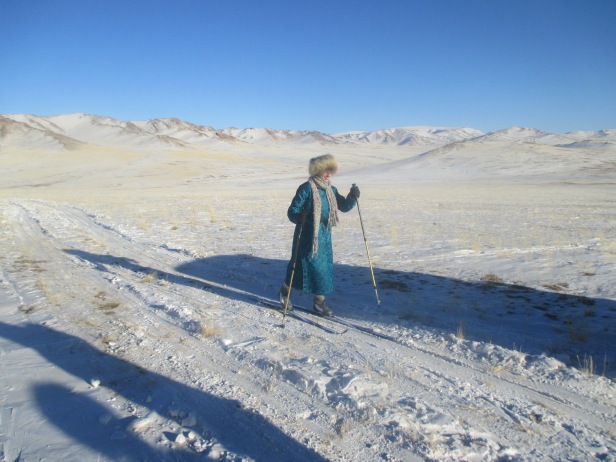
Oh yeah, I’m a pro! (actually, all 3 of us who’d never skied before fell at some point during our short runs; I fell literally the second I put my foot in the bindings)
We finally arrived at Tsagaanchuluut, where we spent the night at our guide’s older sister’s home with her family. Before the sun went down, we ran up the nearby hill to get some pictures with a bunch of Buddhist statues.
Then we had dinner and spent the evening playing cards with their family.
The next morning, we went back up the hill to get a few more photos of the soum:
and the Buddhist statues:
Then we set off for the horse festival, which was taking place about 20km to the south of Tsagaanchuluut. On the way, we saw some Mongolian gazelles!
The festival ended up being delayed a few hours, so we spent that time walking around and taking pictures.
As the only foreigners, we soon attracted a lot of attention. Herders started chatting with us, giving us the zolgokh greeting and exchanging snuff bottles. They were quite impressed that we could actually speak some Mongolian.
Younger herders kept asking us to take their picture.
Finally, the competitions started. For the first event, riders had to reach down–while on their galloping horse–and pick up a blue khadag tied to a small stick that was on the ground, and then pick up their long lasso-pole (called an uurga) that was also on the ground a bit further away.
I even got some video of the event:
The next event consisted of some herders driving a large group of horses through the central area that all the spectators were standing around. The competitor (who was just standing for this event) had to use his lasso-pole to try to catch one of the horses as they ran by.

Yeah, let me just run into this herd of stampeding horses and try to catch one with my rope-on-a-stick
I also got a video of this event, which proved to be quite a challenge, as only 1 or 2 herders managed to successfully catch a horse. Usually the rope just ended up breaking or coming loose even if they did get it around a horse.
At this point the racers from a race that I didn’t even know had started began arriving. Our guide’s nephew ended up coming in 4th place, but by this point my camera battery had died. Unfortunately, we had to leave soon after this, even though there were still more events (like lassoing on horseback, and breaking a horse) that would be happening later (thanks to the delay of the start of the festival). We had to get back to Uliastai that night, and there were ominous-looking clouds in the distance.
Sure enough, as soon as we got back to Tsagaanchuluut for dinner before heading home, it started to snow. And it continued to snow for the entire 5-hour-drive back, in the dark. Luckily we made it home safely and in good time. It was an amazing trip and a great end to the Tsagaan Sar weekend.
NOTE: I did take many more videos during the horse festival (and a random one of the snow a couple weeks ago) but because I’m too lazy to figure out how to combine all these short little videos into a larger compilation video, I just uploaded them all individually to my YouTube channel. So you can check out the other videos there if you so desire.

